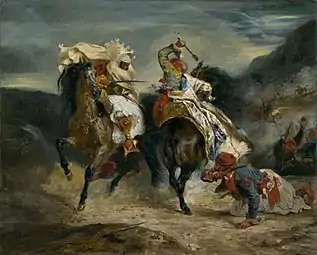Giaour
Giaour or Gawur (/ˈdʒaʊər/; Turkish: gâvur, Turkish pronunciation: [ɟaˈvuɾ]; from Persian: گور gâvor, an obsolete variant of modern گبر gaur, originally derived from Imperial Aramaic: 𐡂𐡁𐡓𐡀, romanized: gaḇrā, lit. 'man; person'; Romanian: ghiaur; Albanian: kaur; Greek: γκιαούρης, romanized: gkiaoúris; Macedonian: каур/ѓаур; Bulgarian: гяур), meaning "infidel", was a slur historically used in the Ottoman Empire for non-Muslims or, more particularly, Christians in the Balkans.[1][2]


Terminology
The terms "kafir", "gawur", and "rûm" (the last meaning "Roman"—actually referring to the Greek population, since they were descended from the Eastern Roman Empire) were commonly used in defters (tax registries) for Orthodox Christians, usually without ethnic distinction. Christian ethnic groups in the Balkan lands of the Ottoman Empire included Greeks (rûm), Bulgarians (bulgar), Serbs (sırp), Christian Albanian (arnavut) and Vlachs (eflak), among others.[2]
The 1911 Encyclopædia Britannica described the term as follows:
Giaour (a Turkish adaptation of the Persian gâwr or gōr, an infidel), a word used by the Turks to describe all who are not Mohammedans, with especial reference to Christians. The word, first employed as a term of contempt and reproach, has become so general that in most cases no insult is intended in its use; for example in parts of China, the term foreign devil has become void of offence. A strict analogy to giaour is found in the Arabic kafir, or unbeliever, which is so commonly in use as to have become the proper name of peoples and countries.
During the Tanzimat (1839-1876), the use of the term by Muslims for non-Muslims was prohibited to prevent problems occurring in social relationships.[3]
European cultural references

- Giaour is the name given to the evil monster of a man in the tale Vathek, written by William Beckford in French in 1782 and translated into English soon after. The spelling Giaour appears in the French as well as in the English translation.[4]
- In 1813 Lord Byron published his poem The Giaour: A Fragment of a Turkish Tale, whose themes revolve around the ideas of love, death, and afterlife in Western Europe and the Ottoman Empire.
- Le Giaour, an 1832 painting by Ary Scheffer, oil on canvas, "Musée de la Vie romantique", Hôtel Scheffer-Renan, Paris.
See also
Notes
- Speros Vryonis (1993). The Turkish State and History: Clio Meets the Grey Wolf. Institute for Balkan Studies. ISBN 978-0-89241-532-8.
The Turkish term "giaour" a term of contempt, was applied to these Balkan Christians,
- Entangled Histories of the Balkans: Volume One: National Ideologies and Language Policies. BRILL. 13 June 2013. p. 44. ISBN 978-90-04-25076-5.
In the Ottoman defters, Orthodox Christians are as a rule recorded as kâfir or gâvur (infidels) or (u)rum.
- Gawrych, George (2006). The Crescent and the Eagle: Ottoman Rule, Islam and the Albanians, 1874-1913. I.B.Tauris. p. 15. ISBN 978-1-84511-287-5.
- Beckford, William (2013). Vathek. OUP Oxford. ISBN 978-0-19-164578-5.
- Pesquisas en la obra tardía de Juan Goytisolo, page 66, Volumen 33 de Foro hispánico, ISSN 0925-8620, Brigitte Adriaensen, Marco Kunz, Rodopi, 2009, ISBN 9042025476, ISBN 9789042025479. Quotes Estambul otomano, page 62, Juan Goytisolo, 1989, Barcelona, Planeta.
References
- This article incorporates text from a publication now in the public domain: Chisholm, Hugh, ed. (1911). "Giaour". Encyclopædia Britannica. Vol. 11 (11th ed.). Cambridge University Press. p. 927.